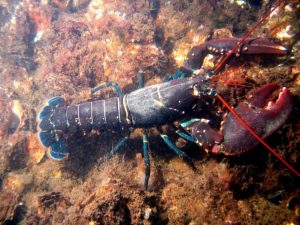Lobster Conservation
Caomhnú Gliomaigh
European Lobster – Homarus gammarus

The European lobster (Homarus gammarus) is dark blue with cream or yellow spots on top, with the underside a more uniform yellow colour. Both sexes have two claws, one designed for crushing while the other is used for cutting.
The European Lobster is territorial, solitary and nocturnal, they favour living in holes and crevices in the seabed during the day. During the summer months they seek mates and it is during this migration that lobster fishing is at its peak. The females carry the eggs for around eleven months before they hatch as planktonic larvae. After a couple of weeks, they burrow into the seabed where they remain for 2 years. When the carapace reaches around 15mm in length they leave their burrows in exchange for crevices in rocky substrate.
Lobster Protection
The ‘V’ Notch Programme was introduced in 1995 to help protect the lobster population from overfishing. It is mostly female lobsters that are V notched to allow them to reproduce. When a lobster is marked in this way, it is illegal to land, possess or sell it and it must be returned, alive, to the sea.
There is by law a minimum landing size of 87mm. On average it takes nine years for a Lobster to reach this size. Female European lobsters mature between 5 and 8 years of age depending on water temperature.

Homarus gammarus and Dingle Oceanworld
In May of 2006, we at Dingle Oceanworld set up a lobster hatchery to rear the eggs of the European Lobster. Every year we raise thousands of European Lobsters larva to the next stage of their life-cycle. It is estimated that in the wild only 1 in 20,000 larvae will reach this stage. Through our lobster hatchery we are raising the odds of the larva of reaching this stage, thereby increasing the lobster populations for years to come.
